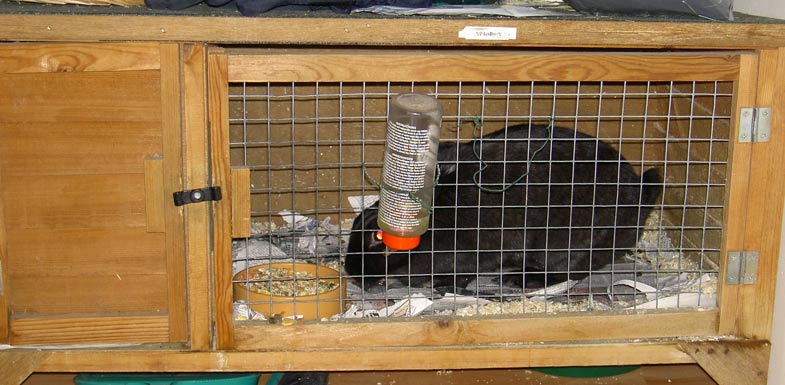Manly sized rabbits need manly sized houses, though determining whether your Flemish Giant will live inside or outside is the first step to choosing what housing types there are to consider. If you’re opting for a giant lap-bunny, you may want him/her to live indoors. Allowing him/her to have free-roam of the home is often fine, as long as someone is there to supervise. But – let’s face it! While big buns can be a lot of fun, they can also get into a lot of trouble even if they are not left un-attended. Otherwise, /she will need a safe place to call home when his/her human-friend just can not be there. If there are extended periods of time through-out the day (or at night) when left alone, perhaps having an outdoor hutch would better serve your needs. In either case, there are multiple types of housing available to give you some ideas to work with, or maybe even combine, to provide the perfect setting for the safety & happiness of your newly beloved giant pet.

One of the basic decisions you will have to make is; will I keep my giant indoors or outdoors?
Indoor set-up options for a Flemish giant
One tried & true safe place for an indoor rabbit, of any breed, is to go to your local pet store & buy a dog-kennel. These can be bought in a variety of colors and sizes. For Flemish Giants, you would want to choose a large kennel, made of heavy metal, with a locking door. They are also ready-for-use with a slide-out pan, which is ideal for litter-droppings. Such type kennels can be kept as-is in a spare room, or even decorated to match the décor of your main living area. The reason for needing such a kennel to be heavily constructed, is for the prevention of “Thumper” from bending wires &/or chewing his/her way out. It will also keep him/her safely away from any electrical wiring throughout the house that most assuredly will end up being chewed thru, resulting in death by electrocution, as well as other reasons; such as shoes, furniture legs, & cushions being turned into chew-toys.
Besides giving your Flemish bunny a good place to stay he also needs to receive proper care. Learn what care your bunny needs in order to be healthy and happy.
Another popular method is the use of a spare-room, storage area, or an enclosed porch which is devoted partially or completely to bunny-life. Keep in mind, too, that laundry rooms do not make ideal places for rabbits, especially the giant breeds, due to the humidity & build up of heat from the appliances. Otherwise, these rooms can be as simple or as fancy as you would like; but it is suggested to remember that a bored bunny could quickly become an accident-waiting-to-happen. So, if you choose this option, be absolutely sure to rabbit-proof the entire room. Make sure that there are no electrical wires of any kind that he/she could reach. Cover electrical outlets with child-proof safety plugs, put away every thing that you do not want damaged – including but not limited to carpet.
In fact, you may find it a bit messy, but your snuggle-bunny will thank you for a floor that could be covered, at least partially, with fresh straw. Or perhaps a concrete or rubber-backing typed rug may be possible. Not only will this save you a lot of expensive home-repairs, such the replacement of carpet or hardwood-flooring, but either the concrete or rubber-backed rugs are easily cleaned and sanitized, plus they safe-guard against the rabbit being injured on a slippery floor. Finally, be sure that you have a way to securely close off the area.
Flemish are naturally inquisitive large rabbits. What do rabbits do? They hop & jump. Therefore, a regular sized baby-gate sitting across a doorway will not be a deterrent when it comes to stopping your new friend from exiting the room whenever he/she decides to do so. In all seriousness, these giants are escape artists in disguise. They easily can & will jump higher than 3 feet. Therefore, it’s important to make sure that whatever you decide to use, you should have a total understanding that nothing will completely replace the security of an actual door that can be opened/closed. Otherwise, don’t be afraid to try out different options. Be creative! If you decide to have an entire bunny-room try adding some tunnels, ramps, toys, & even large tree branches (we’ll discuss which ones are safe in the section for feeding). Your furry friend will love you for it.
Outdoor hutches for a Flemish giant
First & foremost, there is one very important issue when considering any type, size, or design of outdoor rabbit cage, pen, or hutch. What it is that issue? In one word – location! Placement of any type of outdoor living arrangement for rabbits is vital; it literally can make the difference between life & death! With that said, please take note: any & all outdoor living arrangements for rabbits of any breed must be placed in way that also shelters the bunny from all elements of weather & predators. While good ventilation & some sunlight is import, there is a careful line between too much & too little which needs attention given.
Please keep in mind
If there is not adequate ventilation, respiratory problems could arise. In the same respect, little or no sunlight can cause other problems. Too much direct sunlight, as well as other elements such as rain, snow, and wild or aggressive animals can quickly kill your furry-pal & will equally leave you/your family members heart-broken. This is particularly true with Flemish & other giant breeds, as they not only are covered in dense fur, but they have more body-mass, which can increase their risk of heat stroke.

Example of outdoor hutch
Furthermore, although it is not required, it is beneficial to offer a completely enclosed boxed in an area inside or attached to the outside of the hutch. Such an enclosure will offer a place to hide from strong winds, to take a break from the sun, & even as an extra place of escape from an attack by a neighbors’ dog or other wild animal. Such a box can also double as a nest-box, if your gentle-giant is a doe which you plan to breed. (We’ll discuss this in greater detail, in the breeding section of this site.) Otherwise, you will need a galvanized small-size wire to cover the sides of the hutch, as well as the floor – or part of the floor, needs some solid flooring to be used as a resting mat for those great big feet since Flemish are prone to sore hocks. Be mindful here that we are talking about heavy-gauge rolled fence wire, not the type better known as hardware-mess, which is too flimsy to support the weight of a large rabbit. Furthermore, coated wire is even better, as it will not rust like un-coated wire will.
Now, lets move on to size. The bottom line here is that giant breeds definitely require more living space than the smaller or dwarf sized breeds. At the very least, the hutch needs to be tall & wide enough for your great, big-eared buddy to have lots of room to move freely-about. Being as curious as they are, Flemish are also prone to standing on their powerful hind legs. They want to know what is going on around, as well as above them. Due to this, the roof needs to be high enough from the cage floor to allow a fully grown giant to stretch out. In other words, at minimum, the hutch should ideally be 2.5 to 4 feet high, from floor to ceiling. This allows his ears to remain erect, without causing damage or injury to them. Next, length-wise, minimally the hutch should allow for him/her to stretch out completely, without front or hind feet touching the sides, in any direction, of the hutch walls. Therefore, theoretically, you would want the length to be at least 3.5 to 4 feet, with a width matching as close to that perimeter as possible. After all, regardless to your reason for having one of these amazing pets, even their great personality could be affected if they are left to be cramped up for long periods of time in a small pen, where they have no room to move around.
Outside cages – inside
Another option for an outdoor living set-up for your bunny, which is ideal if you are exploring or already devoted to breeding & raising Flemish, would be a wide-variety of designs which can be set up inside a barn or shed, or other similar type of out-building. This option covers the need for building roofs, & other forms of protection against natural elements, as well as most attacks from other animals. In fact, most breeders use this option when possible. There are a lot of different ways inside-pens can be set up. Choices include everything from single hanging cages, which are typically lined up on the walls, pre-made stacked cages, single-cages which are attached to a long wooden or metal frame or there are also units that can be built into or against walls, enclosed with wood and wire, & then there are the much higher-advanced designs which offer automatic waste-collection systems.
OTHER MUST READ ARTICLES:+ : Costs of owning a flemish giant
+ : Feeding my giant
+ : Sexing a flemish giant

